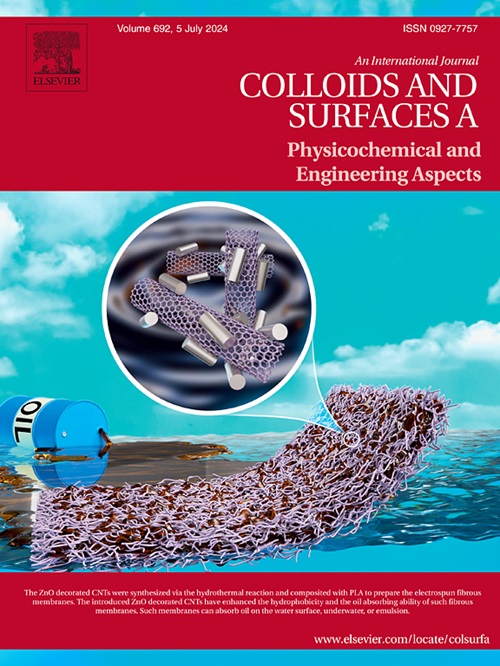用于物理水凝胶的磷酸皂石分散体的 pH 值控制离子流动性,具有更好的机械性能和对二氧化碳的敏感性
IF 4.9
2区 化学
Q2 CHEMISTRY, PHYSICAL
Colloids and Surfaces A: Physicochemical and Engineering Aspects
Pub Date : 2024-11-07
DOI:10.1016/j.colsurfa.2024.135743
引用次数: 0
摘要
制备并测试了基于生物基聚(衣康酸)和 Laponite® 纳米粘土的自组装物理纳米复合水凝胶,可作为智能食品包装中的二氧化碳传感器。通过改变由焦磷酸钠稳定的 Laponite® 水分散体的初始 pH 值,控制了所制备水凝胶的结构和机械性能。分散体采用 SAXS 进行研究,并使用圆盘和分形模型进行分析,以确定粘土的团聚趋势。通过 23Na 和 31P 1D 以及自旋-自旋弛豫时间 T2 NMR 测量,研究了钠离子和焦磷酸盐离子的流动性。通过振荡剪切测量研究了所制备水凝胶的流变特性。研究发现,将 Laponite® 纳米分散液的 pH 值降至 8 会增强纳米粘土、分散剂和聚电解质链之间的物理相互作用,从而生产出尺寸稳定、机械坚固的水凝胶。水凝胶的二氧化碳吸附能力为 0.07 mmol CO2/g,证明了水凝胶作为二氧化碳敏感基质在构建环境友好型比色传感器方面的潜在应用。水凝胶传感器的原型装置已经建成,并在食品包装应用中进行了测试,以监测李子的呼吸过程。本文章由计算机程序翻译,如有差异,请以英文原文为准。
pH-controlled-ion-mobility of Laponite-phosphate dispersion for physical hydrogel with improved mechanical properties and sensitivity to CO2
Self-assembled physical nanocomposite hydrogels based on bio-based poly(itaconic acid) and Laponite® nanoclays were prepared and tested as possible CO2 sensors in smart food packaging. The structure and mechanical properties of the fabricated hydrogels were controlled by changing the initial pH of the aqueous Laponite® dispersions stabilised by tetrasodium pyrophosphate. The dispersions were studied by SAXS and analysed using circular disc and fractal model to determine clay agglomeration tendency. Sodium and pyrophosphate ions mobility was investigated by 23Na and 31P 1D as well as spin-spin relaxation times T2 NMR measurements. The rheological behaviour of the produced hydrogels was studied by oscillatory shear measurements. It was found that decreasing the pH of the Laponite® nanodispersions up to 8 increases the strength of the physical interactions between the nanoclays, dispersant, and polyelectrolyte chains, which enables production of dimensionally stable and mechanically robust hydrogels. Their potential application as the CO2-sensitive matrix for construction of environmentally friendly colorimetric sensors was demonstrated showing the CO2 sorption capacity of 0.07 mmol CO2/g. A prototype device of hydrogel sensor was built and tested in a food packaging application to monitor the plum fruit respiration processes.
求助全文
通过发布文献求助,成功后即可免费获取论文全文。
去求助
来源期刊
CiteScore
8.70
自引率
9.60%
发文量
2421
审稿时长
56 days
期刊介绍:
Colloids and Surfaces A: Physicochemical and Engineering Aspects is an international journal devoted to the science underlying applications of colloids and interfacial phenomena.
The journal aims at publishing high quality research papers featuring new materials or new insights into the role of colloid and interface science in (for example) food, energy, minerals processing, pharmaceuticals or the environment.

 求助内容:
求助内容: 应助结果提醒方式:
应助结果提醒方式:


